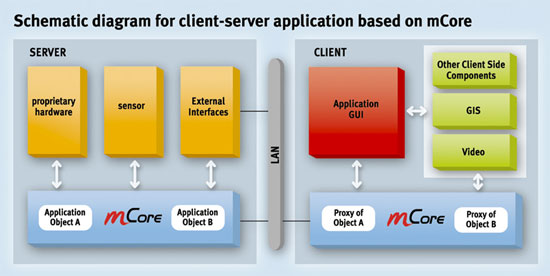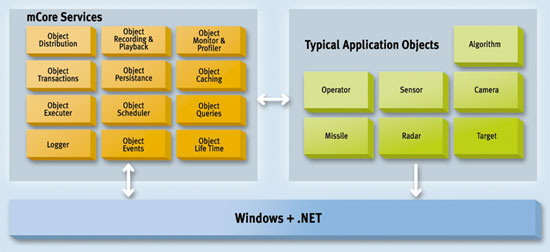![]() |
|
 |
mCore |
 |
|
![]() |
It’s people who face up to today’s complex defense challenges. They need to be able to share information and collaborate rapidly to execute tactical missions and achieve strategic goals.
The cornerstone of today’s defense organizations is an open, secure and interoperable IT infrastructure. Beyond simple connectivity, this demands systems that interoperate with each other seamlessly to provide real-time information, integrated management and secure, resilient communications. Such a holistic environment enables more efficient planning and maximizes defense resources, while providing rich collaboration tools so people can prepare, protect and defend far more effectively.
The importance of command and control
Defense organizations are looking to integrate data from diverse systems and deliver it in real time across the chain of command. With up-to-date information personalized by role, commanders get the full picture instantly and can respond decisively. And they can plan, direct and coordinate forces and equipment more accurately.
The Microsoft platform supports comprehensive command and control solutions which can be securely extended to mobile devices. These provide real-time communication across unit, brigade, division and allied forces. By improving information flow between command centers and operational units, military forces can establish themselves quickly in unfamiliar territory and connect and collaborate in joint and combined operations.
mCore
mCore is a fully integrated command and control application infrastructure solution powered by the Microsoft® .NET Framework and delivered by mPrest Systems. It provides a flexible, robust and reliable foundation for developing advanced command and control applications that enable defense and homeland security organizations to operate far more effectively.
Deployed by leading defense systems integrators, including Rafael, Israeli Aerospace Industries and Elisra Group, mCore is already the basis for some of the world’s most demanding command and control systems for land, air and sea.
Why choose mCore for your command and control infrastructure?
A perfect partnership
mPrest Systems works with defense solution vendors and systems integrators to design and implement command and control systems.
We provide a generic, flexible and responsive software infrastructure called mCore, which is an ideal foundation for developing complex command and control applications. We support your deployment with comprehensive architectural and design consultancy. And to ensure a smooth transition, we also provide training in the Microsoft platform and the Microsoft .NET Framework.
mCore: an advanced development foundation
mCore is a .NET command and control application server that enables rapid development of reliable command and control applications for shared situational awareness and tight operational control. It supports a broad range of applications, including real-time information gathering by sensors, algorithm processing and display interfaces.
By providing a core application layer built on top of the Microsoft .NET Framework, mCore lets your developers work with the most advanced design patterns recommended for the .NET Framework.
A strategic advantage
This high performing and adaptable application infrastructure reduces risk, giving solution vendors a strategic advantage.
mCore target applications
|
Defense command, control, communications, computers and intelligence (C4I) Systems incorporating information |
![]() |
|
collected from sensors (land, airborne and naval) and presented to control personnel. Applications include: radar, electronic warfare, battlefield management, fire control. |
![]() |
|
Defense surveillance and reconnaissance (SR) Systems providing information on the location, identity and movement of hostile and friendly forces on the battlefield. |
![]() |
|
Homeland security Systems for border control, transportation security and emergency management. |
![]() |
|
Simulators for the defense and civil markets Training teams on various airplanes, ships and ground vehicles, as well as situation analysis (on the battlefield or security scenes). |
![]() |
|
Industrial machines Product line inspection, industrial automation machines, robotic systems, etc. |
![]() |
|
Communication systems Backend systems for handling a high volume of object processing (calls/sessions/packets), such as mediation and monitoring systems. |
![]() |
|
Medical machines Large scale machines, comprising several PCs, sensors and complex algorithm processing. |
mCore technical architecture

mCore – a software infrastructure for vertical markets
The leading system topology in developing distributed client-server applications relies on the database as the main mechanism for interaction between objects and object management.
In systems that demonstrate several changes per second per object, the required reaction time cannot be met by a database-centric topology. As commercial application servers are designed for the e-business market, which poses different needs, teams developing command and control systems are forced to develop proprietary software infrastructure for handling fast object management, threading and distribution.
Development of the software part in mission-critical systems is a main element in creating additional value to customers and a competitive edge for advanced technology system vendors. However, systems involving extensive software development often fail to fulfill the requirements, meet the deadline, and/or fit the budget, usually due to infrastructure problems and deficiencies.
As a uniquely tailored command and control application server, mCore is bringing the effective concept of using separate underlying infrastructure for objects and resource management to these markets. Detaching the application from infrastructure issues results in cheaper and simpler development, which is more flexible to changes in technology and operating requirements.
As a dedicated, optimized and field-tested platform, mCore provides a sound base for application development.
mCore capabilities
|
In-memory object management mCore is designed to manage tens of thousands of objects, each changing several times per second. mCore is highly optimized for the efficient handling of memory, CPU, thread-pools, etc. |
![]() |
|
Automatic thread safety mCore automatically guarantees thread safety, eliminating deadlocks and the tedious and error-prone task of locking and unlocking mutual access to objects. mCore greatly increases the scalability of the application by enabling thread pools, while completely concealing the complexity of using them. In addition, mCore’s threading module is extremely flexible, thus enabling the assignment of different methods of objects to |
![]() |
|
independent threads, or thread pools and control of thread priorities. |
![]() |
|
Transparent distribution between servers and clients mCore enables transparent object distribution. Once an object is created on a specific network node (server or client) it can be accessed from any other node (both for reading as well as for writing) as if it were a local object. |
![]() |
|
Simple interface to external systems Where the mCore-based system needs to communicate with an external system having any kind of hardware/software protocol, mCore greatly simplifies the development of these types of interfaces. |
![]() |
|
Recording and playback mCore provides a built-in capability for recording and playing back objects and invocations. This capability is important for the development and integration phases, as well as for the operational system (supporting training and debriefing modes). |
![]() |
|
Object persistence to a database mCore provides the automatic persistence of objects into a database. This capability includes the automatic generation of database schemas and DAL. |
![]() |
|
In-memory queries mCore provides an in-memory query service for objects. The in-memory queries support filtering and caching. |
![]() |
|
In-memory transactions mCore supports in-memory transactions that are executed as an atomic operation, and can be rolled-back in case the operation is not completed successfully. |
![]() |
|
Optimized scheduling mCore supplies efficient and scalable scheduling services designed to efficiently support a large number of scheduling requests and objects. |
![]() |
|
Distributed asynchronous events mCore extends the native .NET event and supports event distribution (subscribing to a remote event and triggering remote objects). mCore events are also triggered asynchronously in the same way as standard mCore invocations, thus leveraging the built-in thread safety mechanisms. |
![]() |
|
Automatic support of binding mCore objects support automatic data binding to GUI .NET controls. |
![]() |
|
Fault tolerance and redundancy mCore supports the demand for high availability of specially designed active-standby server clusters. mCore supports active-passive typology with no additional coding required. |
![]() |
|
Graceful exceptions handling mCore automatically manages un-handled application exceptions at the object method invocation level. This capability greatly improves the availability and reliability of the system, as it ensures graceful handling of exceptions in the user written code. |
![]() |
Benefits of mCore
mCore offers core functionalities and optimized performance that surpass what developers could normally achieve for their system using single project resources, in that it allows developers to focus on their specific application requirements.
Speed up development
Using mCore as a common platform significantly reduces the time and resources required for project development and integration, both between project modules and between projects. System vendors can expect to achieve a reduction of 12-18 man months in project cost and 6-12 weeks in the project integration phase.
Reduce costs
More efficient development results in significant cost savings and increased productivity for highly skilled development teams.
Minimize risk
Project risk is greatly reduced as major issues and problems are dealt with by the platform, making development much simpler and more straightforward. System performance, for example, can be tested and guaranteed at an early stage of the project.
Enhance competitiveness
These key benefits increase system vendor competitiveness by boosting ability to demonstrate superior system and commercial performance over time.
mCore services and typical application objects

|
|
|